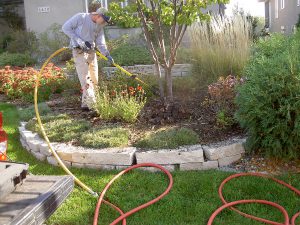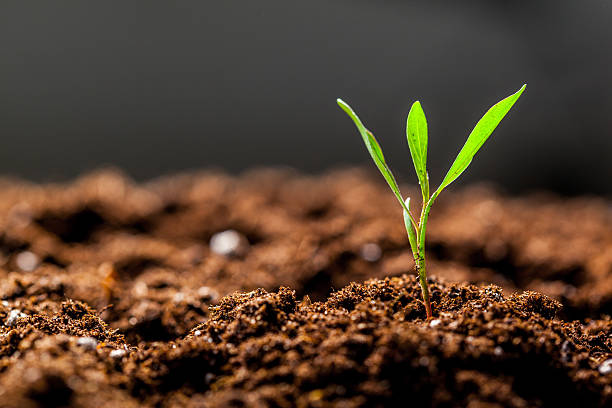Soil fertility refers to the ability of the soil to support the growth of plants. Healthy soil is teeming with beneficial microbes that help to break down organic matter and release nutrients, making them available for plants to take up. In addition, healthy soil has a good structure, with a balance of solid particles and pores that allow for adequate drainage and aeration. This helps to encourage strong root growth, which is essential for plant health. Soil fertility is important because it directly impacts plant growth. Without healthy soil, it would be impossible to grow crops or support any other form of plant life. As such, ensuring the fertility of our soils is essential for both food security and the health of our ecosystems.
Table of Contents
What Is Soil Fertility, and Why Does It Matter?

The difference the right conditions can make in growth rate- both trees were the same size when planted.
How do roots work?
Roots are connected to the leaves of a tree by very small tubes in the sapwood, from top to bottom. Water evaporating from leaves creates suction, which carries all the way down to the roots and draws water in from the soil. Dissolved in this water are some of the minerals and nutrients the tree needs to grow new leaves, create new wood, and protect itself. The remaining nutrients need to be forced into the roots using a process that requires oxygen, just like how we breathe. This sets up a list of soil conditions necessary for roots to thrive:
- The necessary nutrients, in enough quantity and in the correct chemical form to be absorbable
- Small pore spaces filled with water
- Large pore spaces filled with air

Chlorosis is often caused by nutrient deficiencies.
Nutrients
All plants require nitrogen, phosphorous, and potassium in large quantities (macronutrients), as well as many other elements in smaller amounts (micronutrients). These elements are generally present in the soil on undisturbed sites in sufficient quantities and in absorbable forms. By definition, however, our urban and suburban soils are disturbed. These disturbances can lead to soils that lack enough nutrients or have nutrients in a chemical form that tree roots can’t absorb. Nutrients can come from many sources: decaying leaves, weathering of the bedrock, and even added by us.
Pore Space
Similar to nutrients, trees need pore spaces of different sizes and quantities for different purposes. Macropores are large spaces that fill with air, allowing the roots to breathe. Micropores are smaller spaces that retain water after rains or watering stops. In prolonged floods, macropores stay filled with water and can lead to roots suffocating. In droughts, even the micropores can drain leading to soil hardening and compacting. Soil compaction can also occur from driving over or even walking on the root systems of trees, crushing the macropores. Soils without the necessary pore spaces are difficult places for roots to live. This can ultimately lead to reduced root function and tree decline.
How can we help?
Now that we have an understanding of what tree roots need to thrive, we can look at how we can improve soils and provide roots with the best possible growing conditions. We have several methods of fertilization at our disposal to address nutrient deficiencies, and a key technique to help de-compact pore space and incorporate organic matter into soils.
Fertilization

Vineland Plant Healthcare Technician Ed Hayes fertilizing a ginkgo (Ginkgo biloba).
If we suspect a tree is not getting the nutrients it needs based on canopy conditions, fertilization can be one of the most effective tools in our toolbox. Applying a liquid fertilizer can quickly increase available nutrients, allowing for quick green-up of trees experiencing certain types of nutrient deficiencies. Fertilizing can also help young trees adapt to their new environment. In smaller doses fertilization can help maintain the condition of larger, older trees that have been established much longer. We also have granular options, which have the added plus of containing organic matter.

Using an Air Spade to excavate around the base of a Japanese tree lilac (Syringa reticulata).
Decompaction and Soil Amendments
After a compaction event (construction, large gathering, flooding), we can use air excavation to begin de-compacting the soil. This entails removing any sod, mulch, or ground cover, and excavating trenches using high-velocity compressed air. This air is focused to break up compaction without risking damaging the tree roots present in the soil. These trenches are then refilled with the now-loosened soil and a granular fertilizer high in organic matter. This low-nitrogen fertilizer provides less of a push to grow, which is better for trees stressed by compaction as well as older trees. Additionally, adding organic matter helps feed soil micro-organisms that will continue to assist with decompaction into the future.
Soils form the base in which trees grow, both literally and also as the source for raw materials. Maintaining and improving the soil is one of the easiest and most effective ways to improve the health of any tree.

